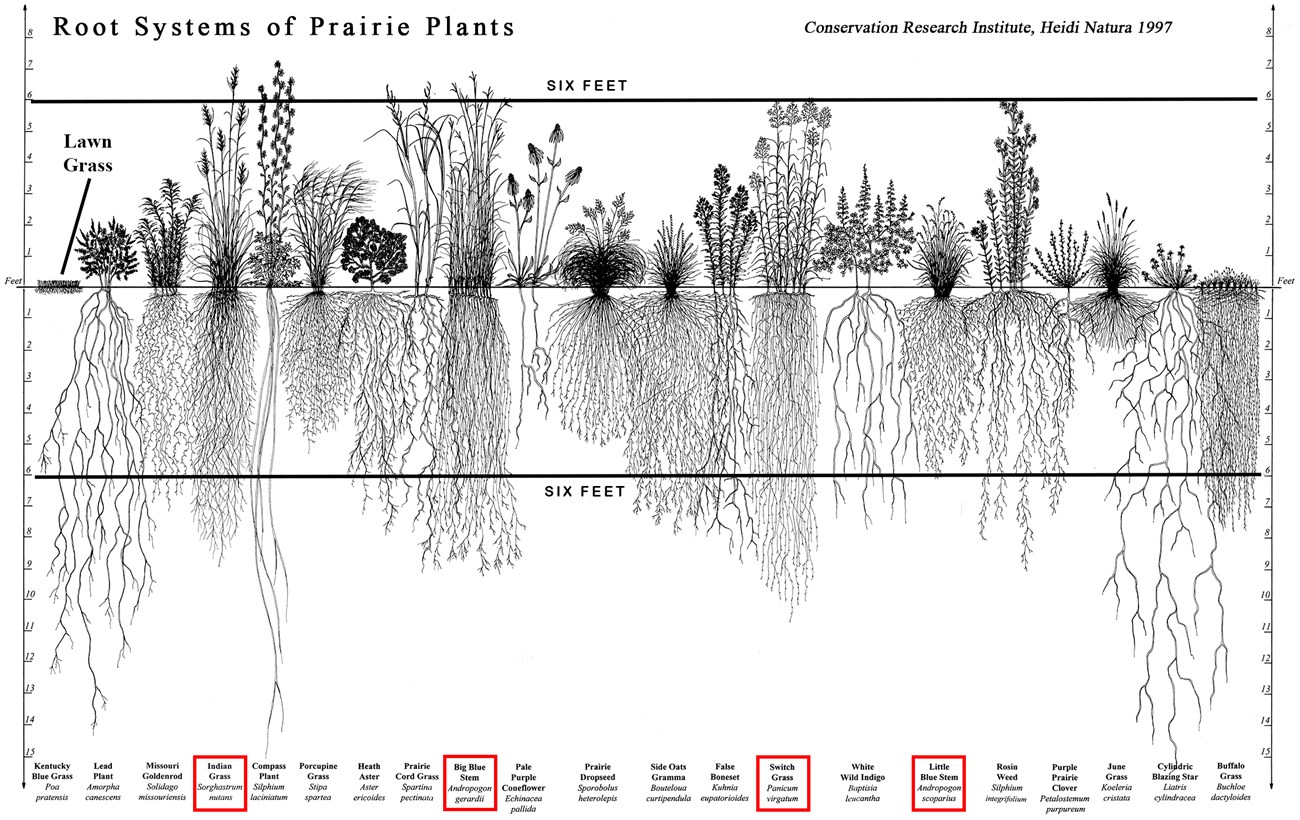Last updated: March 17, 2021
Article
Flint Hills Tallgrasses

Heidi Natura, Conservation Research Institute, 1997
Tall grass and deep roots
Many of these grasses can reach 6 to 8 feet or more in height, with most reaching their full height, given the right location, moisture, and other growing conditions, in the late summer and fall, leading to the helpful phrase “tall in the fall.”
The deep roots of tallgrass prairie grasses enables them to survive harsh conditions, with over 75% of the plant’s biomass located underground. This dense network of roots binds the soil together, like steel in concrete, and helps the grasses absorb moisture and nutrients.
Image Credits
The images in the photo galleries below (unless otherwise noted) are credited to Mike Haddock, Agriculture Librarian and Chair of the Sciences Department at Kansas State University Libraries and editor of the website www.kswildflower.org.The BIG FOUR
These are the four dominant grasses of the Flint Hills tallgrass prairie ecosystem, Big bluestem, Indiangrass, Little bluestem, and Switchgrass. Nearly 75% of the grasses growing in the Kansas Flint Hills are one or more of these four species. However, over 70 different species of grass have been identified in the Kansas Flint Hills region.Upland tallgrass prairie grasses
Upland tallgrass prairie is prime grazing land for a wide range of grazing animals, such as cattle and bison. Shallow, rocky soils and steep hillsides make upland tallgrass prairie difficult to plow for crops, which helps to preserve more of its original characteristics, like high plant diversity and dense, deep root networks. These combine to make upland tallgrass prairie very resilient and adaptable to a wide range of environmental conditions.Bottomland tallgrass prairie grasses
Bottomland tallgrass prairie remains an extremely rare part of the tallgrass prairie ecosystem in the Kansas Flint Hills. These large, level areas with their deep, nutrient-rich soils and better access to moisture were ideal for the planting of crops and other agricultural uses. Since bottomland tallgrass prairie is so rare and could support some of the tallest tallgrasses, the preserve is working to restore several hundred acres of this nearly extinct area to its natural state.Introduced and invasive species
These grasses can be found in some areas of the tallgrass prairie ecosystem, presenting problems in certain circumstances. Some have been introduced for their forage value and for use in lawns, while others are less desirable native species that can become invasive in the right condtions. They can all fiercely compete with more desirable grass species for resources and for that reason the preserve monitors them closely.
GRASSES CHECKLIST BY COMMON NAME
To find more information:1. Highlight the name of the plant you wish to know more about.
2. Right-click with a mouse or choose "Look Up" on a mobile device and select a search option.
3. Depending on your browser and search option, a sidebar or new window will appear with more sources of information about your selected plant.
BLUEGRASS, KENTUCKY Poa pratensis
BLUEGRASS, PLAINS Poa arida
BLUESTEM, BIG Andropogon gerardii
BLUESTEM, CAUCASIAN V Bothriochloa bladhii
BLUESTEM, LITTLE Schizachyrium scoparium
BLUESTEM, SILVER Andropogon saccharoides
BROME, DOWNY Bromus tectorum
BROME, JAPANESE Bromus japonicus
BROME, SMOOTH Bromus inermis
BUFFALO GRASS Buchloe dactyloides
FOWL MANNAGRASS Glyceria striata
FOXTAIL, CAROLINA Alopecurus carolinianus
FOXTAIL, GREEN Setaria viridis
FOXTAIL, YELLOW Setaria glauca
GRAMA, HAIRY Bouteloua hirsuta
GRAMA , SIDEOATS Bouteloua curtipendula
HAIRYSEED PASPALUM Paspalum pubiflorum
JOINTED GOATGRASS Aegilops cylindrica
JUNEGRASS Koeleria pyramidata
OLDFIELD THREEAWN Aristida oligantha
PANICUM, SCRIBNER Dichanthelium oligosanthes
PANICUM, TANGELED Dichanthelium acuminatum
PLAINS MUHLY Muhlenbergia cuspidata
PRAIRIE CORDGRASS Spartina pectinata
PRAIRIE CUPGRASS Eriochloa contracta
PURPLE LOVEGRASS Eragrostis spectabilis
PURPLETOP Triden flavus
ROUGH BARNYARD GRASS Echinochloa muricata
ROUGH DROPSEED Sporobolus asper
STINKGRASS Eragrostis cilianensis
SWITCHGRASS Panicum virgatum
VIRGINIA WILD RYE Elymus virginicus
WHITEGRASS Leersia virginica
WINDMILL GRASS Chloris verticillata
WIRESTEM MUHLY Muhlenbergia frondosa
WITCHGRASS Panicum capillare
Useful books and plant identification websites
- Barnard, Iralee. Field Guide to the Common Grasses of Oklahoma, Kansas, and Nebraska. University Press of Kansas, 2014.
- Brown, Lauren. Grasses: An Identification Guide. Houghton Mifflin, 1979.
- Great Plains Flora Association. T.M. Barkley, editor. Flora of the Great Plains. University Press of Kansas, 1986.
- Haddock, Michael John. Wildflowers and Grasses of Kansas: A Field Guide. University Press of Kansas, 2005.
- Clark, Lynn G. and Richard W. Pohl. Agnes Chase’s First Book of Grasses. Smithsonian Institution Press, 1996.
- Kansas Native Plants Society: www.kansasnativeplantsociety.org
- Kansas Wildflowers and Grasses: www.kswildflower.org
- United States Department of Agriculture PLANTS database: plants.sc.egov.usda.gov
